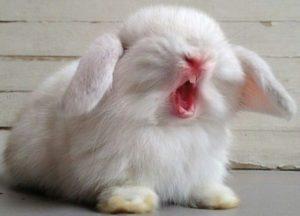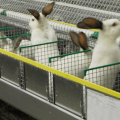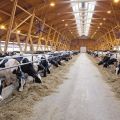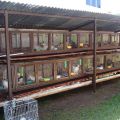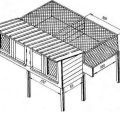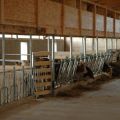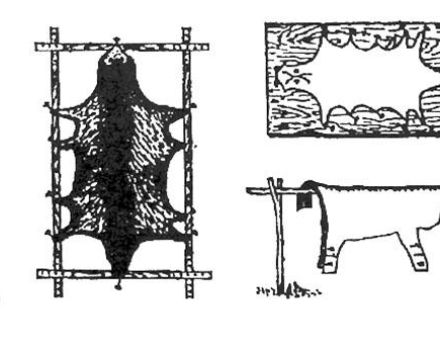Types of mini-farms for rabbits, drawings and how to make it yourself
Keeping rabbits in a common enclosure is not practiced. In this case, it is impossible to maintain the purity of the breed and it is difficult to maintain order. Modern rabbit breeders use the invention of the naturalist and academician I. N. Mikhailov - a compact mini-farm. Animals are distributed in separate cages, which allows you to control reproduction. Small compartments are easy to clean. The advantage of a mini rabbit farm is that it is easy to build it yourself.
What are the benefits of business
Breeding rabbits in a special design is included in the acceleration technique of Academician Mikhailov. Thanks to his invention, the survival rate of rabbits, the quality of the skins, and the meat turns out to be soft.
The rabbit farm has the following advantages:
- the cubs are next to the mother in the mother liquor, feed on her milk and by the age of three months they receive strong immunity;
- after switching to regular food, young rabbits fed on breast milk quickly gain weight;
- the excreta disposal system and the manure collector under the residential level allow less time for cleaning, the animals do not get dirty, and the meat does not acquire an unpleasant odor;
- in the bunker feeders, food is kept clean and always available.
It is profitable to do business with the help of a rabbit farm, as the animals do not get sick, they give tender meat and soft skins. The fur of rabbits raised according to the Mikhailov method is called micraxel and is equated in quality with the fur of chinchilla, nutria and polar fox. Micraxel clothing retains the integrity and color of the pile up to 20 years.

The mini farm accommodates 12-30 rabbits and is 1.4 square meters. There will be 16 farms on 100 square meters. Large-scale production can be set up in a small area. Thanks to the intelligent organization of the space for keeping rabbits, maintenance costs are reduced.
Varieties of mini-farms
The design developed by Academician Mikhailov consists of one or several levels. Rabbits can be sorted by age, sex. Each compartment is equipped with a feeder and drinker. The sizes are selected individually, so that the rabbit moves freely in its "apartment".
Types of mini-farms:
- country house - designed for a small number of individuals, consists of one level, is placed indoors; auto drinkers, hopper troughs and faeces disposal system allow you to leave animals unattended;
- industrial - consists of several levels, accommodates a large number of rabbits, an insulated structure is placed outside, provided with the necessary equipment for the comfort of rabbits;
- decorative - intended for keeping decorative species in the summer outdoors;
- backyard - a multi-level structure for breeding rabbits in the backyard, equipped with a heating system or not heated.
It is better to start breeding with a small number of rabbits and a single-tier design. With the addition of animals on top, you can add one or more levels.
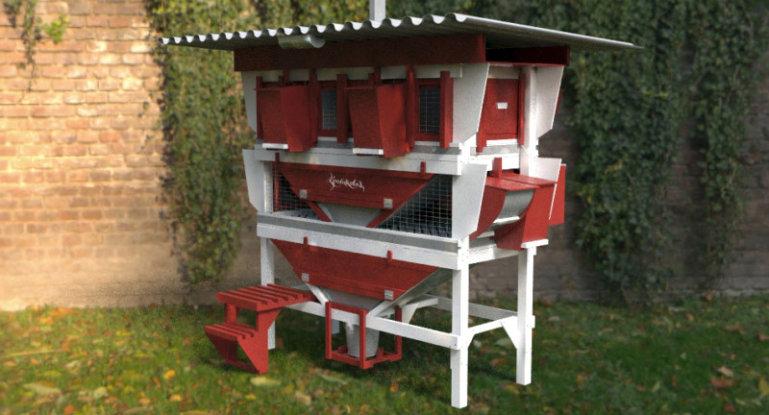
How to make a mini farm with your own hands
Ready-made mini trusses can be made from low quality materials that do not retain heat, or metal grates. Rabbits in such a dwelling are sick. Constant contact with metal on the floor causes pododermatitis on the paws.
For a small farm, it is safer to build a mini-farm yourself.
Drawing creation
The main elements of the mini-farm:
- nests or compartments - compartments where rabbits live;
- walking compartments - with drinkers and feeders;
- compartments for jigging with mother liquor - for keeping pregnant rabbits and cubs.
Drinking bowls and feeders are placed in the walking compartments between residential nests and a passage is made to them for rabbits: for one animal on one side or for two on both sides. Also, the plan provides for places for bunker feeders and automatic drinkers.

Rabbit compartment parameters:
- length - 150 centimeters;
- width - 70 centimeters;
- height - 50 centimeters.
Components of the structure:
- tier frame;
- compartment doors;
- pitched mine for waste;
- internal dampers of nesting compartments;
- manure tank.
Feeders, drinkers and nurseries are located inside the nests. A tank is placed under the farm, into which waste from the pitched mine gets. If the farm will be located outside, you need to make electric heating of drinkers and mother liquors. At temperatures below +10 degrees, the dwelling of rabbits must be constantly heated.
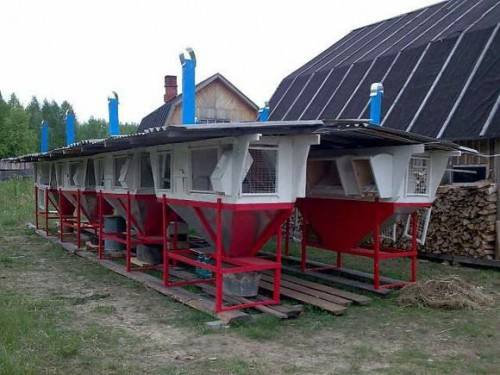
Purchase of materials
A mini rabbit farm is built from simple materials:
- plywood;
- Chipboard;
- galvanized iron;
- metal mesh with large links;
- foam;
- wooden bars and slats.
Outdoor construction will require power cords and roofing felt. Wooden parts must be impregnated with an animal-safe antiseptic that prevents mold.
Instruments
For work you will need:
- saw;
- drill;
- a hammer;
- scissors for cutting metal.
The frame parts are connected with screws or nails. Doors and dampers will need to be cut out of individual boards.
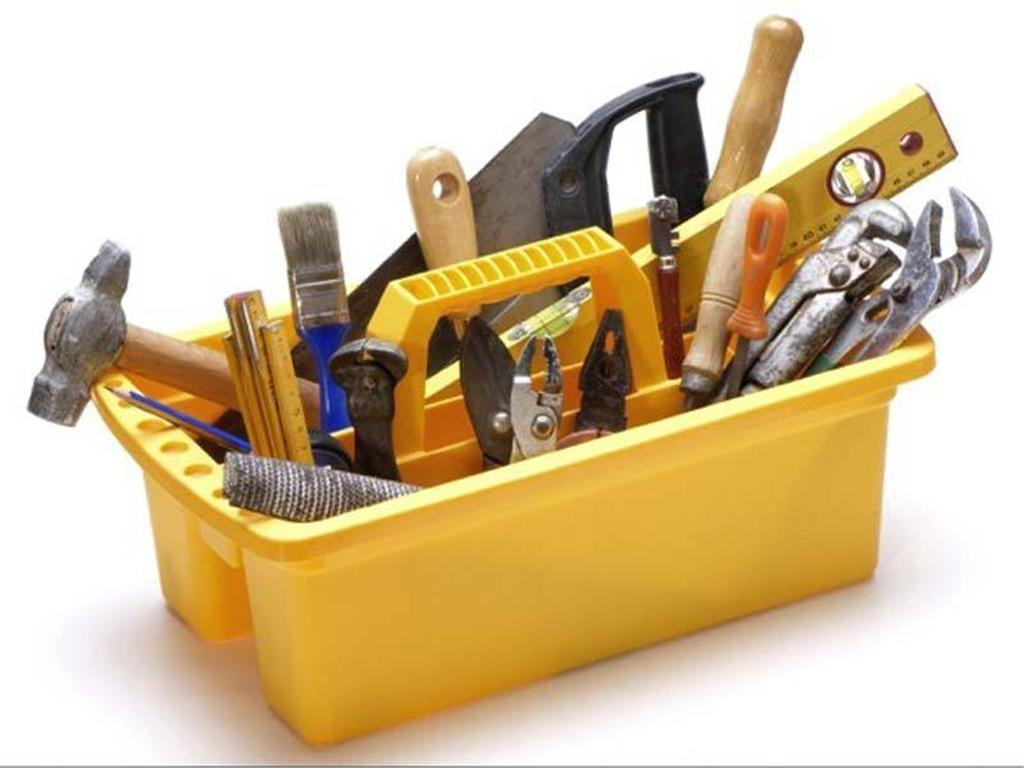
Manufacturing steps
Basic building skills are sufficient to build a simple one-level structure of two compartments.
Stages of work:
- erection of the base - 4 wooden bars are installed vertically, connected with horizontal bars;
- installation of a frame for the compartments - they put vertical slats, denoting compartments for animals;
- formation of a drain - under the compartments, iron sheets are fixed in the form of a cone, the drains are installed at the joints of two compartments;
- installation of floors in rabbit compartments - fix the board at an angle of 45 degrees, and a net above the litter drain. Waste will go to the drain along the sloping floor;
- erection of walls - compartments are separated by wooden boards.
The sophisticated design, consisting of walking compartments and queen cells, is installed on a longer base. The walls of the cubicle compartment are lined with foam for insulation, and the floor is made even, without a hole for waste.
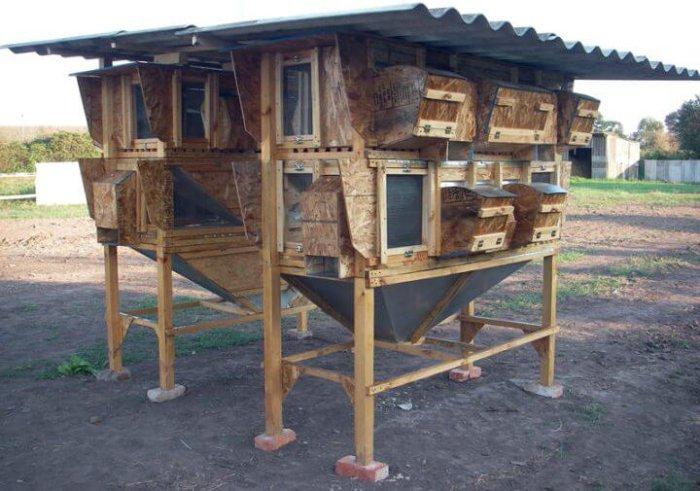
The back wall of the truss is covered with plywood sheets. Doors are installed on the compartments in front. They can be hinged or moved to the side. The door is made translucent, made of wooden slats and mesh. The street structure is covered with a sloped pitched roof so that rainwater can drain off quickly.
Drinking bowls and feeders are hung on the doors or next to them so that the dishes are easy to reach. For roughage and vegetables, separate containers are required. The herb nursery is hung from the door.
Where to locate a rabbit farm?
Mini farm locations:
- backyard;
- outbuilding;
- near the wall of the house under a canopy.
The rabbit farm is placed in a free space of 2x2 meters. The approach to the design must be free. To protect animals from drafts on the street, the structure is placed with its back wall to the north, on the south side of the site.

How to choose the right rabbit
Before equipping the farm, you need to decide on the direction of production or what product you plan to receive.
Rabbit breeds intended for industrial breeding:
- meat - Californian, white New Zealand;
- fur - burgundy, chinchilla;
- meat-skinned - German giant, Flanders.
To start a rabbit business, breeds are suitable, from which both products are obtained - meat and skin.
For breeding, 10 females and 1-2 males are recruited. Animal selection criteria:
- age - preference is given to young animals 4-6 months old;
- external signs - healthy individuals have a clean, shiny coat, clear eyes and a friendly character;
- relationship - males and females should not be from the same litter.
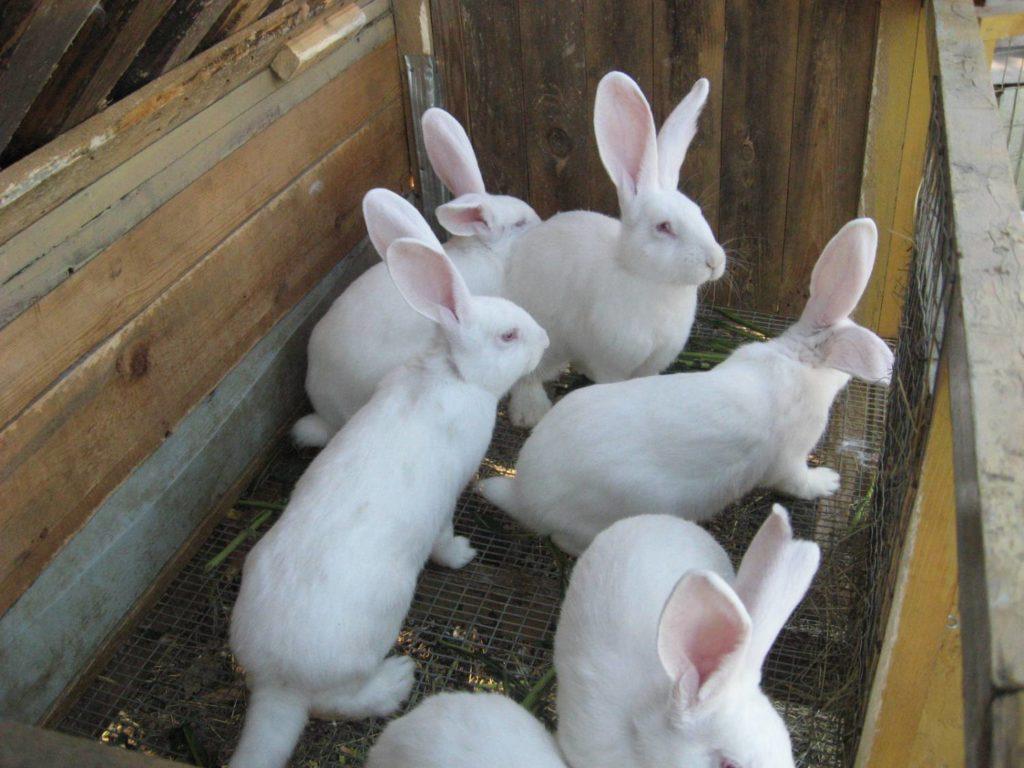
Crossbreeding of closely related animals will result in the birth of weak cubs.
Ready examples
For breeding rabbits at home, two types of mini-farms are used - Mikhailov and the improved Maklyak-6.
An example of a design according to Mikhailov:
- the cells are united by a gable roof and form a shed;
- a mesh or metal sheets are installed under the base, forming a conical drain for the droppings;
- consists of one or two levels.
Features of the mini-farm "Maklyak-6"
- designed for street content;
- consists of modules that can be changed;
- mother liquors are heated using infrared lamps.
Also in rabbit breeding, a farm design is used according to the scheme of NI Zolotukhin, which differs in the structure of levels. Three floors are located with a shift back. At the rear of the compartments, there are openings for faeces and pathways for their disposal.
The mothers are accommodated in the darkened part of the compartments and are fenced off with a pull-out plate. Feeders are built into the doors, slide out and inside the compartments. It is convenient to add food or grass in them. Based on the examples of mini-farms, you can come up with your own rabbitry scheme. The main principles of construction are compactness, animal comfort and ease of care.
